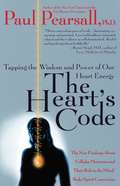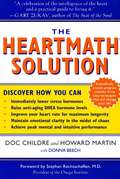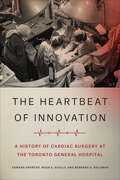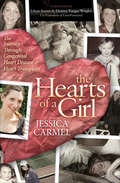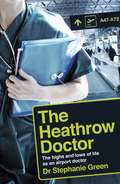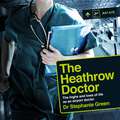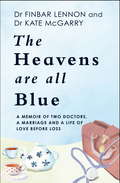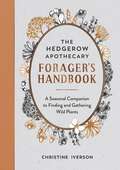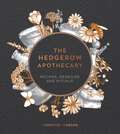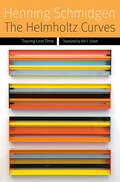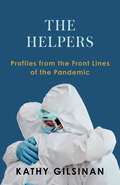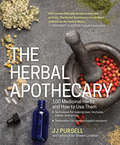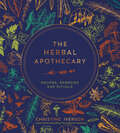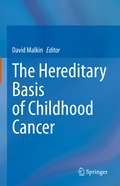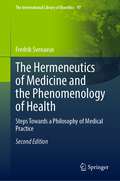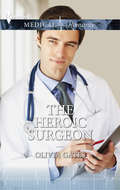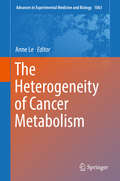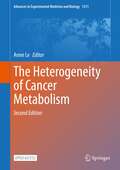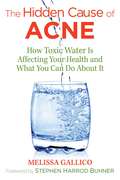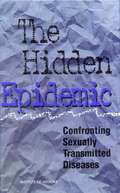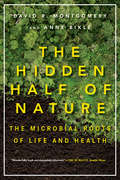- Table View
- List View
The Heart's Code
by Paul P. PearsallA fascinating synthesis of ancient wisdom, modern medicine, scientific research, and personal experience that proves that the human heart, not the brain, holds the secrets that link body, mind, and spirit. You know that the heart loves and feels, but did you know that the heart also thinks, remembers, communicates with other hearts, helps regulate immunity, and contains stored information that continually pulses through your body? InThe Heart's Code,Dr. Paul Pearsall explains the theory and science behind energy cardiology, the newly emerging field that is uncovering one of the most significant medical, social, and spiritual discoveries of our time. The heart is not just a pump; it conducts the cellular symphony that is the very essence of our being. Ten years ago, Pearsall, who was then running a clinical and research center at a major hospital, knew he had cancer long before his doctors confirmed his self-diagnosis. His heart was crying out that something was seriously wrong, but his doctors and colleagues dismissed his misgivings and said he was overstressed. Months later, Pearsall was diagnosed with Stage IV lymphoma with a small chance of survival. But he did survive, and his experience led him to enter research and make discoveries that are nothing short of revolutionary. Pearsall, the author of theNew York TimesbestsellersSuperimmunityandThe Pleasure Prescription,explains how we live in a society that is run by our brains, not our hearts, and why this is damaging to us on a personal and sociological level. Pearsall shows that by listening to the subtle energy and wisdom each of us has within our hearts, we can learn valuable lessons for loving, working, playing, praying, and healing. Full of amazing stories of transplant recipients who experienced profound changes in their lifestyles and cancer patients who recognized their illness before diagnosis, as well as data from scientists and sources on cellular memory and the power of subtle energy, Pearsall explores what these breakthroughs mean for the rest of us. By unlocking the heart's code we can discover new ways of understanding human healing and consciousness, even as we create a new model for living that leads to better health, happiness, and self-knowledge.
The Heart: Our Circulatory System
by Seymour SimonYou know your heart beats, but did you know it beats over two billion times in a lifetime? You know you have veins, but did you know that the upper vena cava is as wide as a pencil and brings blood from your brain and upper body back to your heart? You know blood flows, but did you know your veins have valves like parachutes that open and close to keep blood from flowing backwards? You know you have red blood cells, but did you know that if they were stacked on top of each other they'd make a column thirty thousand miles high? Blood flows through arteries and veins. Do you know the difference between them? Discover what jobs the white and red blood cells do to keep you alive. Learn the parts of your heart and the blood vessels that let your blood flow to every part of your body. You'll learn new, big words like: septum, hemoglobin, atria, valve, ventricles, plasma, cells, pulmonary, veins, arteries, marrow, venules, alveoli, neutrophils, capillaries, sinoatrial node, and upper and lower vena cava. Find how a muscle the size of a large sweet potato keeps you alive. You'll be interested and learning as you read and you'll become smart about your heart. Read other books by this author from Bookshare including The Brain, Mars, Muscles and Bones.
The HeartMath Solution
by Doc Childre Howard MartinThe Intelligent HeartAccess the power of your heart's intelligence to improve your focus and creativity, elevate your emotional clarity, lower your stress and anxiety levels, strengthen your immune system, promote your body's optimal performance, and slow the aging process.
The Heartbeat of Innovation: A History of Cardiac Surgery at the Toronto General Hospital
by Edward Shorter Hugh E. Scully Bernard S. GoldmanGreat innovations take place within great institutions. Founded in 1819, Toronto General Hospital (TGH) is one of Canada’s oldest hospitals and has created a nurturing environment for early Canadian innovations in heart surgery. The Heartbeat of Innovation tells the story of the brilliant surgeons who worked there and the hospital environment that provided an incubator to the many people – skilled perfusionists, dedicated nurses, and pioneering cardiologists – who participated in the revolution in heart surgery that took place along University Avenue in Toronto. Supported by historical records, hospital archives, personal memoirs, and interviews, this book is an extensive and descriptive account of the seemingly inexorable development of cardiac surgery at this leading academic health science centre. It pursues several themes: the complexity of this surgical specialty, its generally male-dominated nature, the trend toward teamwork in practice, and the evolution and incorporation of original research into this branch of healthcare. These strands are woven together to demonstrate how the TGH has evolved into such a dominant leader in the competitive and demanding field of cardiac surgery. Canadian hearts may beat with pride at the knowledge that one of the major stories in modern medicine took place here – and continues here.
The Hearts of a Girl: The Journey Through Congenital Heart Disease & Heart Transplant
by Jessica CarmelA riveting medical memoir about a family&’s journey through multiple surgeries, and a determined battle for survival. Jessica Carmel was born with a severe congenital heart condition. When she was just four days old, her parents learned she would need heart surgery. They had no idea that her future held multiple surgeries and even more unexpected challenges. Sixteen years later, as Jessica sat in her cardiologist&’s office for a routine checkup, he told her and her mom that there was nothing more he could do for her. Jessica needed a heart transplant. Three weeks later, Jessica underwent heart transplant surgery. Her recovery was long, but good—but about ten years later, she learned that she was in desperate need of a new kidney. Her only hope of survival was her sister, Amy—who heroically offered up one of her own kidneys. Now their mother would be seeing both of her daughters off to the operating room . . . This remarkable story of one young woman&’s journey through the medical maze—including financial struggles and battles with insurance companies—and a family&’s determination to survive and thrive together, is both an informative, fascinating look at health care and an uplifting, inspiring read.
The Heathrow Doctor: The Highs And Lows Of Life As An Airport Doctor
by Dr Stephanie GreenAn exhilarating insight into the life of a doctor at Heathrow Airport, where the truth is often stranger than fiction.For over a decade, Stephanie Green was a doctor on-call for one of the world's busiest airports, confronting dramatic, bizarre and sometimes heart-breaking situations. During her 24-hour shifts at Heathrow, Dr Green had to be ready for anything: from finding an abandoned suitcase leaking blood onto the carousel, to discovering a man smuggling heroin in a corset.It's a job that brought her into contact with all walks of life; her patients included drug mules and fugitives, schizophrenics and stowaways, refugees and tourists. And with the threats of a nerve agent poisoning or a Level Four viral epidemic always in the back of her mind, Dr Green found herself on the frontline where the decisions are made about who - or what - was allowed to leave the airport's borders.THE HEATHROW DOCTOR reveals the thrilling drama that takes place behind-the-scenes of an airport and what is needed to make critical decisions in this hidden no-man's land of geopolitics, terror, tragedy and medicine.*Previously published as 'Flight Risk'.
The Heathrow Doctor: The Highs And Lows Of Life As An Airport Doctor
by Stephanie GreenAn exhilarating insight into the life of a doctor at Heathrow Airport, where the truth is often stranger than fiction.For over a decade, Stephanie Green was a doctor on-call for one of the world's busiest airports, confronting dramatic, bizarre and sometimes heart-breaking situations. During her 24-hour shifts at Heathrow, Dr Green had to be ready for anything: from finding an abandoned suitcase leaking blood onto the carousel, to discovering a man smuggling heroin in a corset.It's a job that brought her into contact with all walks of life; her patients included drug mules and fugitives, schizophrenics and stowaways, refugees and tourists. And with the threats of a nerve agent poisoning or a Level Four viral epidemic always in the back of her mind, Dr Green found herself on the frontline where the decisions are made about who - or what - was allowed to leave the airport's borders.THE HEATHROW DOCTOR reveals the thrilling drama that takes place behind-the-scenes of an airport and what is needed to make critical decisions in this hidden no-man's land of geopolitics, terror, tragedy and medicine.*Previously published as 'Flight Risk'.
The Heathrow Doctor: The Highs and Lows of Life as a Doctor at Heathrow Airport
by Dr Dr Stephanie GreenAn exhilarating insight into the life of a doctor at Heathrow Airport, where the truth is often stranger than fiction.For over a decade, Stephanie Green was a doctor on-call for one of the world's busiest airports, confronting dramatic, bizarre and sometimes heart-breaking situations. During her 24-hour shifts at Heathrow, Dr Green had to be ready for anything: from finding an abandoned suitcase leaking blood onto the carousel, to discovering a man smuggling heroin in a corset.It's a job that brought her into contact with all walks of life; her patients included drug mules and fugitives, schizophrenics and stowaways, refugees and tourists. And with the threats of a nerve agent poisoning or a Level Four viral epidemic always in the back of her mind, Dr Green found herself on the frontline where the decisions are made about who - or what - was allowed to leave the airport's borders.THE HEATHROW DOCTOR reveals the thrilling drama that takes place behind-the-scenes of an airport and what is needed to make critical decisions in this hidden no-man's land of geopolitics, terror, tragedy and medicine.*Previously published as 'Flight Risk'.(P)2018 Headline Publishing Group Ltd
The Heavens Are All Blue: A memoir of two doctors, a marriage and a life of love before loss
by Dr Finbar Lennon Dr Kathleen McGarryWhen Dr Kate McGarry was diagnosed with an advanced cancer of unknown origin she resolved to write a book to chart her experience: as a woman coming to terms with such devastating news and what this meant to her as a wife and a mother but also, crucially, how she experienced cancer and its treatment as a doctor, who had become a patient. As Kate adjusted to living with cancer and underwent treatment, she enlisted the help of her husband, fellow doctor, Finbar to help her write the book but then she sadly passed away on the 5 January 2018. With no writing experience, and wrestling with his own heartache, Finbar set about finishing their story. The result is a touchingly beautiful memoir about love, grief and togetherness.'A loving memoir of time spent both together and apart ... [Kate's] personal legacy, as a mother, a wife and the life and soul of the party, is recorded beautifully in this moving memoir' Sunday Business Post
The Heavens Are All Blue: A memoir of two doctors, a marriage and a life of love before loss
by Dr Finbar Lennon Dr Kathleen McGarryWhen Dr Kate McGarry was diagnosed with an advanced cancer of unknown origin she resolved to write a book to chart her experience: as a woman coming to terms with such devastating news and what this meant to her as a wife and a mother but also, crucially, how she experienced cancer and its treatment as a doctor, who had become a patient. As Kate adjusted to living with cancer and underwent treatment, she enlisted the help of her husband, fellow doctor, Finbar to help her write the book but then she sadly passed away on the 5 January 2018. With no writing experience, and wrestling with his own heartache, Finbar set about finishing their story. The result is a touchingly beautiful memoir about love, grief and togetherness.'A loving memoir of time spent both together and apart ... [Kate's] personal legacy, as a mother, a wife and the life and soul of the party, is recorded beautifully in this moving memoir' Sunday Business Post
The Hedgerow Apothecary Forager's Handbook: A Seasonal Companion to Finding and Gathering Wild Plants
by Christine IversonLearn to forage in the hedgerows like the herbalists of the pastAs many of us look for ways to live a more planet-friendly lifestyle, the sustainable and ethical art of foraging offers us a way to connect with the world around us. It is a practice rich in tradition and steeped in history, and one that links us to our past and our future.This foraging companion is designed to be taken with you on your adventures into the hedgerows, forests and woodland all year round. Helpfully arranged by season, this book includes clear photographs to aid plant identification, ideas on how best to prepare and preserve your finds, fascinating foraging and plant folklore, and handy pages to make your own notes and drawings.Additional features:- A month-by-month foraging calendar- Advice on foraging etiquette and tips for creating a forager's toolkitThis is the essential guide to enjoying the bountiful delights of the hedgerows.
The Hedgerow Apothecary: Recipes, Remedies and Rituals
by Christine IversonLearn to forage in the hedgerows like the herbalists of the past with this best-selling beginner’s guide.For centuries our ancestors looked to nature not just for food, but also for healing. To this day, our ancient hedgerows, woodlands and forests are still full of remedies – and they’re waiting to be discovered.This is the essential guide to enjoying the bountiful delights of the natural world. Learn how to make delicious preserves, healing balms, soothing toddies and cures for colds with nature’s jewels such as rose hips, elderberries and mugwort.You will also find:Photographs to help you safely identify edible plantsAdvice on what is available in each seasonGuidance on how best to prepare and preserve your findsThe fascinating folklore and history of foragingEvery walk is an opportunity to learn, identify a new plant, gather something to eat and reconnect with nature – so dive in to begin your foraging adventure.
The Helmholtz Curves: Tracing Lost Time (Forms of Living)
by Henning SchmidgenThis book reconstructs the emergence of the phenomenon of “lost time” by engaging with two of the most significant time experts of the nineteenth century: the German physiologist Hermann von Helmholtz and the French writer Marcel Proust.Its starting point is the archival discovery of curve images that Helmholtz produced in the context of pathbreaking experiments on the temporality of the nervous system in 1851. With a “frog drawing machine,” Helmholtz established the temporal gap between stimulus and response that has remained a core issue in debates between neuroscientists and philosophers.When naming the recorded phenomena, Helmholtz introduced the term temps perdu, or lost time. Proust had excellent contacts with the biomedical world of late-nineteenth-century Paris, and he was familiar with this term and physiological tracing technologies behind it. Drawing on the machine philosophy of Deleuze, Schmidgen highlights the resemblance between the machinic assemblages and rhizomatic networks within which Helmholtz and Proust pursued their respective projects.
The Helpers: Profiles from the Front Lines of the Pandemic
by Kathy GilsinanA deeply moving narrative of the coronavirus pandemic, told through portraits of eight individuals who worked tirelessly to help others. In March 2020, COVID-19 overtook the United States, and life changed for America. In a matter of weeks the virus impacted millions, with lockdown measures radically reshaping the lives of even those who did not become infected. Yet despite the fear, hardship, and heartbreak from this period of collective struggle, there was hope. In The Helpers, journalist Kathy Gilsinan profiles eight individuals on the front lines of the coronavirus battle: a devoted son caring for his family in the San Francisco Bay Area; a not-quite-retired paramedic from Colorado; an ICU nurse in the Bronx; the CEO of a Seattle-based ventilator company; a vaccine researcher at Moderna in Boston; a young chef and culinary teacher in Louisville, Kentucky; a physician in Chicago; and a funeral home director in Seattle and Los Angeles. These inspiring individual accounts create an unforgettable tapestry of how people across the country and the socioeconomic spectrum came together to fight the most deadly pandemic in a century. Beautifully written and profoundly moving, The Helpers is about ordinary people who stepped up to meet an extraordinary moment. “This is the story of how we beat the pandemic,” Gilsinan writes, “but I hope that it someday serves as an introduction to the story of how we made a better country. That future starts with people like the ones in this book.”
The Herbal Apothecary: 100 Medicinal Herbs and How to Use Them
by Jj Pursell“A brilliant addition to any library.” —Rosemary Gladstar, herbalist and bestselling author More and more people are exploring the healing possibilities of plant-based medicines, and health shops across the country now stock their shelves with natural remedies, but treatments can easily be made at home. The Herbal Apothecary profiles 100 of the most important medicinal plants with striking photographs and step-by-step instructions for making herbal teas, tinctures, compresses, and salves to treat everything from muscle strain to the common cold or anxiety. This holistic guide also includes advice for the home gardener on growing and foraging for medicinal plants. Incorporating traditional wisdom and scientific information, The Herbal Apothecary provides an accessible and comprehensive introduction to plant-based medicine. With the guidance of naturopath JJ Pursell, herb enthusiasts can learn how to safely create their own remedies using plants they know and love.
The Herbal Apothecary: Recipes, Remedies and Rituals
by Christine IversonFrom the best-selling author of The Hedgerow Apothecary, The Garden Apothecary and The Hedgerow Apothecary Forager's Handbook Learn the sustainable and ethical art of the apothecarist with this beautiful photographic guide to working with herbs and spices to make healing remedies and delicious recipes. Discover the fascinating properties and therapeutic benefits of everyday ingredients found in herb gardens and kitchen cupboards. For centuries, herbalists and healers have looked to nature for remedies and have made salves, toddies, teas, balms and preserves as cures for common ailments and to add piquant aromas and flavours to dishes - and now you can too. Inside you will find:- Photographs to help you safely identify edible plants - Advice on what is available in each season - Guidance on how best to grow, prepare and preserve your herbs and spices - Useful herbal remedies and delicious recipes to try - The fascinating folklore and history of these majestic aromatic plants
The Herbal Apothecary: Recipes, Remedies and Rituals
by Christine IversonFrom the best-selling author of The Hedgerow Apothecary, The Garden Apothecary and The Hedgerow Apothecary Forager's Handbook Learn the sustainable and ethical art of the apothecarist with this beautiful photographic guide to working with herbs and spices to make healing remedies and delicious recipes. Discover the fascinating properties and therapeutic benefits of everyday ingredients found in herb gardens and kitchen cupboards. For centuries, herbalists and healers have looked to nature for remedies and have made salves, toddies, teas, balms and preserves as cures for common ailments and to add piquant aromas and flavours to dishes - and now you can too. Inside you will find:- Photographs to help you safely identify edible plants - Advice on what is available in each season - Guidance on how best to grow, prepare and preserve your herbs and spices - Useful herbal remedies and delicious recipes to try - The fascinating folklore and history of these majestic aromatic plants
The Hereditary Basis of Childhood Cancer
by David MalkinThis volume elaborates on the research and clinical implications of the hereditary and molecular basis of childhood cancers. The focus of the ‘disease-related’ chapters of the book is to integrate what is known about the molecular basis of that particular clinical entity (or group of related entities) with the clinical manifestations, to relate the relationship of the molecular oncologic pathways with relevant developmental or non-human species biology in order to better understand the complexity of these systems. The resulting clinical implications of understanding this biology are elaborated on. Chapters 13-16 discuss the broader psychosocial, ethical and genetic counseling issues that arise and that are so critical to translating the knowledge gained from advances in molecular genetics into the clinic. Chapter 12 in particular provides a unique perspective of the application of this knowledge in less-developed nations where ‘modern’ technologies may not be readily available, but where the clinical manifestations of these disorders are prevalent.
The Hermeneutics of Medicine and the Phenomenology of Health: Steps Towards a Philosophy of Medical Practice (The International Library of Bioethics #97)
by Fredrik SvenaeusThis is the first monograph to deal with medicine as a form of hermeneutics, now in a thoroughly revised and updated edition, including a whole new chapter on medical ethics. The book offers a comprehensive philosophical argument why good medical practice cannot be curtailed to scientific investigations of the body but is a form of clinical hermeneutics performed by health-care professionals in dialogue with their patients. Medical hermeneutics is rooted in a phenomenology of illness which acknowledges and proceeds from the ill party’s bodily feelings, everyday life-world circumstances and self-understanding in aiming to restore health.The author shows how the works of classical phenomenologists and hermeneuticians – Martin Heidegger, Maurice Merleau-Ponty, Hans-Georg Gadamer and Paul Ricoeur – may be employed to understand how medical diagnosis is enveloped by professional empathy and clinical judgement and developed by scientific investigations of the patient’s bodily condition. Health and illness are ultimately considered to be ways of feeling at home or not at home in the world, and such experiences are the starting point of medical hermeneutics when aiming to make best use of scientific knowledge. The book is aimed at researchers and teachers in philosophy of medicine and medical ethics, and at physicians, nurses and other health-care professionals meeting with patients in ethically complex and challenging situations. Phenomenology and hermeneutics, most often considered as methods belonging to the humanities, are shown to be of vital importance for the understanding of medical practice and ethical dilemmas of health care.
The Heroic Surgeon
by Olivia GatesDangerous devotion The Global Aid Organization gives Gulnar the chance to forget her past in the urgency of the present. Her dedication to nursing casualties leaves no room for love. But she begins to question her resolve when stunning surgeon Dante Guerriero steps in to help in an emergency situation and saves hundreds of lives in the process. Dante doesn't think of himself as a hero. It's easy to be courageous when you have nothing left to lose. But Gulnar's fi re and passion are bringing him back to life, reminding him that bravery means nothing without love....
The Heterogeneity of Cancer Metabolism (Advances in Experimental Medicine and Biology #1063)
by Anne LeGenetic alterations in cancer, in addition to being the fundamental drivers of tumorigenesis, can give rise to a variety of metabolic adaptations that allow cancer cells to survive and proliferate in diverse tumor microenvironments. This metabolic flexibility is different from normal cellular metabolic processes and leads to heterogeneity in cancer metabolism within the same cancer type or even within the same tumor. In this book, we delve into the complexity and diversity of cancer metabolism, and highlight how understanding the heterogeneity of cancer metabolism is fundamental to the development of effective metabolism-based therapeutic strategies. Deciphering how cancer cells utilize various nutrient resources will enable clinicians and researchers to pair specific chemotherapeutic agents with patients who are most likely to respond with positive outcomes, allowing for more cost-effective and personalized cancer therapeutic strategies.
The Heterogeneity of Cancer Metabolism (Advances in Experimental Medicine and Biology #1311)
by Anne LeThis open access volume will introduce recent discoveries in cancer metabolism since the publication of the first edition in 2018, providing readers with an up-to-date understanding of developments in the field.Genetic alterations in cancer, in addition to being the fundamental drivers of tumorigenesis, can give rise to a variety of metabolic adaptations that allow cancer cells to survive and proliferate in diverse tumor microenvironments. This metabolic flexibility is different from normal cellular metabolic processes and leads to heterogeneity in cancer metabolism within the same cancer type or even within the same tumor. In this book, the authors delve into the complexity and diversity of cancer metabolism and highlight how understanding the heterogeneity of cancer metabolism is fundamental to the development of effective metabolism-based therapeutic strategies for cancer treatment. Deciphering how cancer cells utilize various nutrient resources will enable clinicians and researchers to pair specific chemotherapeutic agents with patients who are most likely to respond with positive outcomes, allowing for more cost-effective and personalized cancer treatment.This book has four major parts. Part one will cover the basic metabolism of cancer cells, followed by a discussion of the heterogeneity of cancer metabolism in part two. Part three addresses the relationship between cancer cells and cancer-associated fibroblasts, and the new part four will explore the metabolic interplay between cancer and other diseases. This new section makes the book unique from other texts currently available on the market. The second edition will be useful for cancer metabolism researchers, cancer biologists, epidemiologists, physicians, health care professionals in related disciplines, policymakers, marketing and economic strategists, among others. It may also be used in courses such as intro to cancer metabolism, cancer biology, and related biochemistry courses for undergraduate and graduate students.
The Hidden Cause of Acne: How Toxic Water Is Affecting Your Health and What You Can Do about It
by Stephen Harrod Buhner Melissa GallicoAn investigation into the root cause of the modern acne epidemic--fluoride--and how to remove it from your diet and lifestyle for clear, healthy skin • Chronicles the existing acne research to reveal fluoride was behind the rise of teenage acne in the mid-20th century and the dramatic increase in adult acne today • Details how to avoid fluoridated foods and beverages as well as other common sources of fluoride, such as pesticides, pharmaceuticals, and household products • Explains how to displace fluoride stored in your bones and other tissues through nutrition and the careful use of iodine According to a recent study, over 20 percent of men and 35 percent of women experience acne after the age of 30. At the same time, remote indigenous societies--such as the Inuit before they “moved to town” in the 1960s--experience no acne at all, even among their teenagers. Many things have been cited as causing acne, from sugar, chocolate, or pizza to dirty pillowcases, hormones, or genetics, but none of these “causes” have been able to explain the majority of acne cases, nor why chronic acne is on the rise. Using her FBI intelligence analyst skills, Melissa Gallico identifies fluoride as the root cause of the modern acne epidemic. Chronicling the existing acne research, she reveals where each study went wrong and what they missed. She shares her personal 20-year struggle with severe cystic acne not only on her face, but on her neck, chest, back, and even inside her ears. She explains how her travels around the world and her intelligence work helped her pinpoint exactly what was causing her treatment-resistant flare-ups--fluoridated water, foods, dental products, and the systemic build-up of childhood fluoride treatments. She details how to avoid fluoridated foods and beverages and explains how sources of fluoride work their way deeply into our daily lives through water as well as fluoride-based pesticides, pharmaceuticals, and common household products. The author exposes the corrupt science used to convince people of fluoride’s health benefits and examines the systemic toxicity of fluoride, including its anti-thyroid and neurotoxin effects, how it remains in the body for years, and how it can cause the symptoms of illnesses, such as arthritis, fibromyalgia, and depression. She explains how to displace fluoride stored in your bones and tissues through nutrition and the careful use of iodine. Offering a guide to freeing yourself from persistent adult acne, Gallico shows that it is possible to heal your skin even when dermatologists and their prescriptions have failed.
The Hidden Epidemic: Confronting Sexually Transmitted Diseases
by Committee on Prevention Control of Sexually Transmitted DiseasesThe United States has the dubious distinction of leading the industrialized world in overall rates of sexually transmitted diseases (STDs), with 12 million new cases annually. About 3 million teenagers contract an STD each year, and many will have long-term health problems as a result. Women and adolescents are particularly vulnerable to these diseases and their health consequences. In addition, STDs increase the risk of HIV transmission.The Hidden Epidemic examines the scope of sexually transmitted infections in the United States and provides a critical assessment of the nation's response to this public health crisis. The book identifies the components of an effective national STD prevention and control strategy and provides direction for an appropriate response to the epidemic. Recommendations for improving public awareness and education, reaching women and adolescents, integrating public health programs, training health care professionals, modifying messages from the mass media, and supporting future research are included.The book documents the epidemiological dimensions and the economic and social costs of STDs, describing them as "a secret epidemic" with tremendous consequences. The committee frankly discusses the confusing and often hypocritical nature of how Americans deal with issues regarding sexuality--the conflicting messages conveyed in the mass media, the reluctance to promote condom use, the controversy over sex education for teenagers, and the issue of personal blame.The Hidden Epidemic identifies key elements of effective, culturally appropriate programs to promote healthy behavior by adolescents and adults. It examines the problem of fragmentation in STD services and provides examples of communities that have formed partnerships between stakeholders to develop integrated approaches.The committee's recommendations provide a practical foundation on which to build an integrated national program to help young people and adults develop habits of healthy sexuality.The Hidden Epidemic was written for both health care professionals and people without a medical background and will be indispensable to anyone concerned about preventing and controlling STDs.
The Hidden Half of Nature: The Microbial Roots of Life and Health
by David R. Montgomery Anne BikléA riveting exploration of how microbes are transforming the way we see nature and ourselves--and could revolutionize agriculture and medicine. Prepare to set aside what you think you know about yourself and microbes. Good health--for people and for plants--depends on Earth's smallest creatures. The Hidden Half of Nature tells the story of our tangled relationship with microbes and their potential to revolutionize agriculture and medicine, from garden to gut. When David R. Montgomery and Anne Biklé decide to restore life into their barren yard by creating a garden, dead dirt threatens their dream. As a cure, they feed their soil a steady diet of organic matter. The results impress them. In short order, the much-maligned microbes transform their bleak yard into a flourishing Eden. Beneath their feet, beneficial microbes and plant roots continuously exchange a vast array of essential compounds. The authors soon learn that this miniaturized commerce is central to botanical life's master strategy for defense and health. They are abruptly plunged further into investigating microbes when Biklé is diagnosed with cancer. Here, they discover an unsettling truth. An armada of bacteria (our microbiome) sails the seas of our gut, enabling our immune system to sort microbial friends from foes. But when our gut microbiome goes awry, our health can go with it. The authors also discover startling insights into the similarities between plant roots and the human gut. We are not what we eat. We are all--for better or worse--the product of what our microbes eat. This leads to a radical reconceptualization of our relationship to the natural world: by cultivating beneficial microbes, we can rebuild soil fertility and help turn back the modern plague of chronic diseases. The Hidden Half of Nature reveals how to transform agriculture and medicine--by merging the mind of an ecologist with the care of a gardener and the skill of a doctor.
